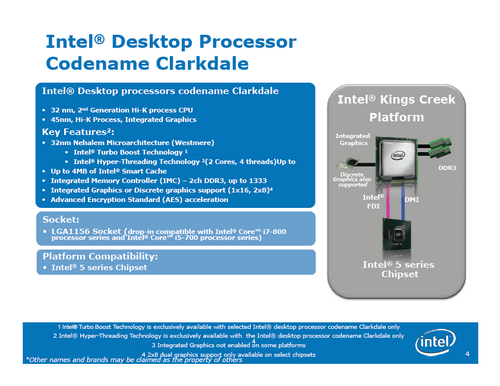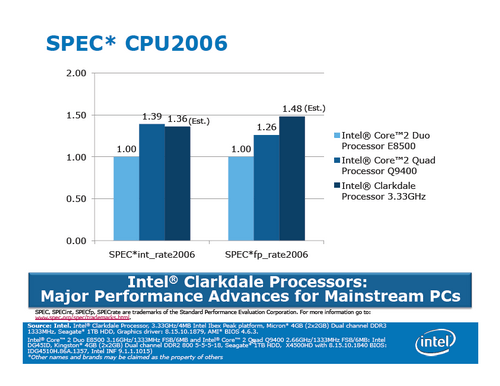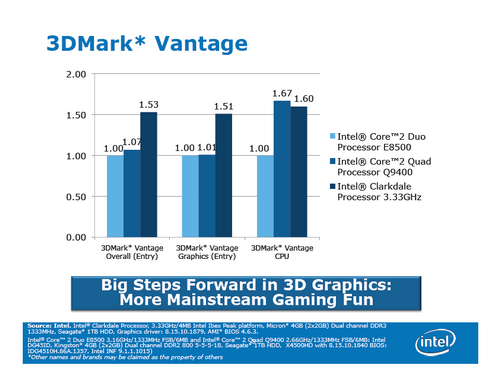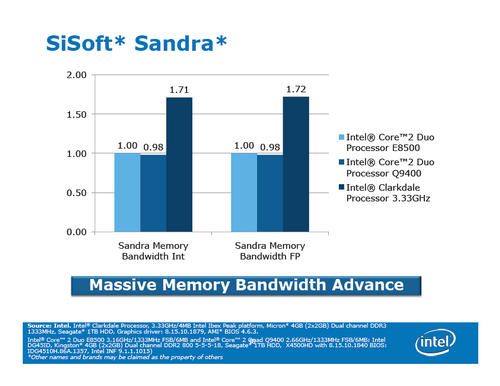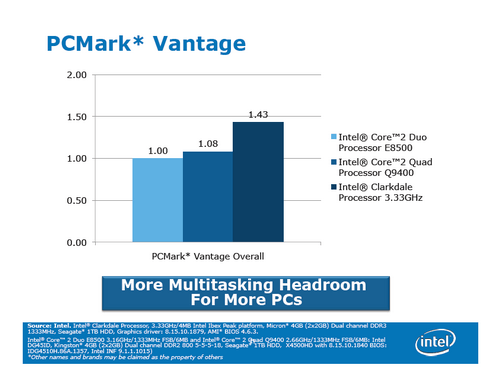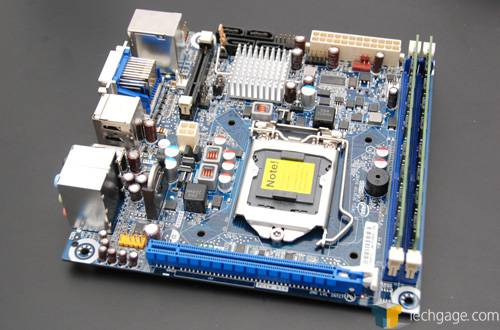- Qualcomm Launches Snapdragon 4 Gen 2 Mobile Platform
- AMD Launches Ryzen PRO 7000 Series Mobile & Desktop Platform
- Intel Launches Sleek Single-Slot Arc Pro A60 Workstation Graphics Card
- NVIDIA Announces Latest Ada Lovelace Additions: GeForce RTX 4060 Ti & RTX 4060
- Maxon Redshift With AMD Radeon GPU Rendering Support Now Available
IDF 09 SF: More On Clarkdale & Arrandale
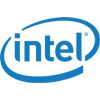
During a private meeting with Intel during IDF 09, more details were divulged about their upcoming Westmere architecture, which includes the Clarkdale desktop and Arrandale mobile chips. Although most of the information has been speculated for a while, we have some initial performance and power consumption details, and things are looking quite good.
If I had to choose just one trade show to attend each year, it might well be IDF. The reason? I always leave the event feeling a lot smarter than I did when I went in… it never fails. This year was quite exciting in many ways, but it was also very different than previous years in many ways as well. As you can tell from our coverage up to this point, Intel is really, really focusing on all things mobile.
So with little focus on the desktop during the primary keynotes, it was good to sit down with Intel’s performance team to learn more about Clarkdale and Arrandale, also known as Westmere. What’s Westmere? Well, you might recall an article we wrote about it towards the beginning of this year, and hopefully you do, because aside from Larrabee, it’s one of the most interesting products on the horizon from Intel.
Westmere will not only become Intel’s first processor built on a 32nm node, but it will also be the first to include a GPU on the same chip, potentially increasing graphics performance compared having it located elsewhere on the board. The gains from this change shouldn’t be too stark, but it seems that the launch chip will be around 50% faster than current G45 offerings.
In addition to the implementation of a graphics core (both the CPU and GPU are separate chips, but both are placed side-by-side on the same processor), this Dual-Core offering will be the first to introduce an added instruction for AES encryption. It’s called AES-NI, and as you’d expect, programs that are designed to take advantage of the AES algorithm can perform much, much faster on Westmere – as long as the application is coded to take advantage of it.
You can see a basic run-down of Westmere in the slide above, but not much of the information there is brand-new. One important thing to note, though, is that Westmere will work in any LGA1156 (P55-only, currently) motherboard… all that will be needed would be a BIOS update.
During our meeting with Intel, we were shown some initial performance results, but they were few. Because Westmere is a derivative of Nehalem, you can picture what the performance boost would be like over Dual-Core Core 2-based processors, and for the most part, that’s just what we saw throughout the results we were given. Below are the results from SPEC CPU2006:
Clarkdale is a fresh product, so it’s no surprise to see it perform well here, but note the competition… a Quad-Core and high-end Core 2 Dual-Core. The Clarkdale sample chip clocks in at 3.33GHz, while the Quad-Core settles at 2.66GHz. Despite having double the cores, albeit with a lessened frequency, the Clarkdale outperforms the Quad by a healthy amount in the floating-point test, while it comes very, very close in the integer test.
It’s normally odd to compare a Quad-Core to a Dual-Core, but it’s easy to see why Intel chose to do so. Their Clarkdale is pretty-much just as fast as a Core 2 Quad of a similar speed… at least, that’s what we can gather from Intel’s less-than-ideal comparative chips. That of course won’t be a regular happening, though. Here’s 3DMark Vantage results:
Once again, we have rather stark increases, but this time, it’s based on the integrated GPU. There’s roughly a 50% increase in performance, so it’s notable. This is still integrated graphics, however. So despite the increase, we’re still talking about 1024×768 or other modest resolutions in equally-modest games. Intel stressed that when they talk about mainstream games on their integrated parts, they’re referring to the top sellers, such as games like The Sims, Spore, World of Warcraft and so forth.
What about memory bandwidth, you ask? The answer is revealed:
This particular result isn’t too important as far as I’m concerned, because memory bandwidth has been fantastic for a while, and where desktop consumers are concerned, we tend to have a lot more than we need to begin with. But either way, with Clarksdale, you can expect to see a ~70% increase in bandwidth thanks to the newly-implemented memory controller.
Finally, a PCMark Vantage result, showing Clarksdale as having yet another noteworthy gain:
Nehalem was released last fall, and even at this point, those processors are designed for enthusiasts and serious gamers. Lynnfield, released just a few weeks ago, is as Intel put it, “for the mainstream”. Clarkdale goes even better: “Nehalem for all”. So in addition to featuring things like faster performance, better power consumption and overall improved efficiency, we’ll also have HyperThreading and Turbo Boost. And of course, to sweeten the deal, we see the introduction of the AES-NI instruction set.
Whatever your take on Clarkdale and its mobile counterpart (Arrandale), Intel has high hopes for their “hybrid” (quotes because it’s not really hybrid… both chips are still separate), and for probably good reason. It’s not so much that the performance will be much greater because of the new location of the GPU, but the fact that we’re condensing what was two chips into one. That leaves more space to deal with.
Plus, like Lynnfield, Westmere-based chips remove the need for a typical Northbridge, so we’re essentially combining two chips and removing one. As a result, we’ll be able to build small systems as before, but do more with them. Below, you can see a sample of a miniITX board that the company was showing off:
You’ll notice that like other miniITX boards, even those that utilize Atom, there’s just not room to do too much, and if the board is cluttered, it usually means worse cooling performance. But here, there’s even room for a PCI-E graphics card (or TV tuner) if you wanted to add one, and there’s plenty of room around the CPU socket for a modest CPU cooler (Intel showed another sample with their stock cooler, and there was plenty of room remaining).
If there’s one reason to look forward to Clarkdale, it would be for this reason. If people are building a desktop, then the added cost for a discrete GPU isn’t going to be too hard to stomach, but for those who want to build the smallest machine possible, it’s a little tougher. But if Clarkdale manages to deliver the performance we need, especially where HD content is concerned (Intel has had issues with their G45 in the past), then Clarkdale should sell quite well.
One of the best aspects of both Clarkdale and Arrandale is the fact that when using one in a machine or notebook, cooling is going to become a little bit easier. You’ll be dealing with just one chip, not two, and that’s a big plus. It might even allow you to overclock the GPU just a wee bit if you like, since it will be sharing the same heatsink as the CPU.
Aside from the general information shown, we were also given demos of an Arrandale machine, with executing a batch process with numerous photos. Long story short, Arrandale won by a fair margin, and it’s not too surprising. Applications such as this thrive on things like HyperThreading and of course, Turbo. Also on display was a Clarkdale machine and equivalent machine with G45. The G45 machine at idle settled around 40W, while the Clarkdale at max load hit 70W.
The launch of both Westmere processors is mum right now, but I’ve been told that it’s likely to be very early 2010, with our launch article to likely happen right around the same time. I was hoping to see at least Clarkdale launch before the holiday season, but Intel must want to play it safe. We’re in the middle of a recession, and with lots of gifts to buy, few are going to want to build a new PC.
With the Windows 7 launch happening next month, Intel took the time to go over some of the details about how the OS handles things like idle tasks and core parking, and I was glad to hear their comments on it. In their opinion, Windows 7 is far smarter than Vista when it comes to proper handling of tasks and thread priority, and also with regards to SMT and Core parking and idle states. Good to know… as these are nice features for multi-taskers.
Stay tuned to the site in the months to come, as we’ll be covering Westmere in more detail when details become available, and on the Windows 7 side, we’re in the works of developing a performance comparison article there, so you won’t want to miss it.
Discuss this article in our forums!
Have a comment you wish to make on this article? Recommendations? Criticism? Feel free to head over to our related thread and put your words to our virtual paper! There is no requirement to register in order to respond to these threads, but it sure doesn’t hurt!
Support our efforts! With ad revenue at an all-time low for written websites, we're relying more than ever on reader support to help us continue putting so much effort into this type of content. You can support us by becoming a Patron, or by using our Amazon shopping affiliate links listed through our articles. Thanks for your support!




